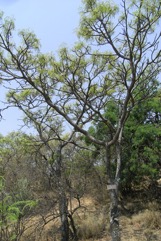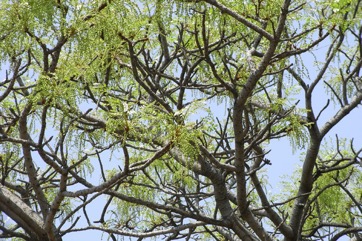Rhodesian ash, Red syringa

A tropical plant. It occurs in sandy areas of dry open bush. In South Africa it grows from 600-1370 m altitude. It needs an annual rainfall above 450 mm. In Zimbabwe it grows in areas with a rainfall between 850-950 mm per year. It can grow in salty soils. It does not suit wet soils. It can grow in arid places.
Also known as:
Djinnou, Kassinamunho, Kauidze, Mosheshe, Mufhulu, Mukarati, Mukoso, Omutundungu, Umnondo, Wild seringa
Edible Portion
- Gum, Bark - drink
Where does Rhodesian ash grow?
Found in: Africa, Angola, Benin, Botswana, Burkina Faso, Cameroon, Central Africa, Congo, East Africa, Ethiopia, Ghana, Guinea, Guinée, Malawi, Mali, Mozambique, Namibia, Nigeria, Senegal, Sierra Leone, South Africa, Southern Africa, Sudan, Tanzania, Togo, Uganda, West Africa, Zambia, Zimbabwe
Notes: In Africa a popular caterpillar eats this tree and these are roasted and eaten by people. This legume tree does not form nodules. Also as Caesalpinaceae.
Growing Rhodesian ash, Red syringa
Cultivation: Plants do not grow easily from seed. Plants have roots near the surface and when these are damaged, new shoots develop and plants can be grown by cutting these off and replanting.
Edible Uses: The gum is eaten. The bark is used for flavouring spirits and beer. The leaves are used as a yeast.
Nutrition Info
per 100g edible portion| Edible Part | Energy (kcal) | Protein (g) | Iron (mg) | Vitamin A (ug) | Vitamin c (mg) | Zinc (mg) | % Water |
|---|---|---|---|---|---|---|---|
| Sap | - | - | - | - | - | - |
Rhodesian ash, Red syringa Photos



References
Achigan-Dako, E, et al (Eds), 2009, Catalogue of Traditional Vegetables in Benin. International Foundation for Science.
Bonou, A., et al, 2013, Valeur economique des Produits Forestiers Non Ligneux (PFNL) au Benin. Editions Universitaires Europeennes p 94
Chapman, J. D. & Chapman, H. M., 2001, The Forest Flora of Taraba and Andamawa States, Nigeria. WWF & University of Canterbury. p 182
Drummond, R. B., 1981, Common Trees of the Central Watershed Woodlands of Zimbabwe, National Herbarium Salisbury. p 60
Fowler, D. G., 2007, Zambian Plants: Their Vernacular Names and Uses. Kew. p 30
Fox, F. W. & Young, M. E. N., 1982, Food from the Veld. Delta Books. p 225
Grivetti, 1976, 1979,
Grivetti, L. E., 1980, Agricultural development: present and potential role of edible wild plants. Part 2: Sub-Saharan Africa, Report to the Department of State Agency for International Development. p 30
Icon. Pl. 6: t. 593-594. 1843
Lee, 1979,
Mannheimer, C. A. & Curtis. B.A. (eds), 2009, Le Roux and Muller's Field Guide to the Trees and Shrubs of Namibia. Windhoek: Macmillan Education Namibia. p 136
Mbuya, L.P., Msanga, H.P., Ruffo, C.K., Birnie, A & Tengnas, B., 1994, Useful Trees and Shrubs for Tanzania. Regional Soil Conservation Unit. Technical Handbook No 6. p 142
Palgrave, K.C., 1996, Trees of Southern Africa. Struik Publishers. p 266
Palmer, E and Pitman, N., 1972, Trees of Southern Africa. Vol. 2. A.A. Balkema, Cape Town p 841
Peters, C. R., O'Brien, E. M., and Drummond, R.B., 1992, Edible Wild plants of Sub-saharan Africa. Kew. p 121
Rodin, 1985,
Roodt, V., 1998, Trees & Shrubs of the Okavango Delta. Medicinal Uses and Nutritional value. The Shell Field Guide Series: Part 1. Shell Botswana. p 187
Royal Botanic Gardens, Kew (1999). Survey of Economic Plants for Arid and Semi-Arid Lands (SEPASAL) database. Published on the Internet; http://www.rbgkew.org.uk/ceb/sepasal/internet [Accessed 21st April 2011]
Ruiters-Welcome, A. K., 2019, Food plants of southern Africa. Ph.D. thesis. Univ. of Johannesburg p 56
van Wyk, B, van Wyk, P, and van Wyk B., 2000, Photographic guide to Trees of Southern Africa. Briza. p 75
van Wyk, Ben-Erik, 2019, The diversity and multiple uses of southern African legumes. Australian Systematic Botany, 2019, 32, 519–546
World Checklist of Useful Plant Species 2020. Royal Botanic Gardens, Kew
www.zimbabweflora.co.zw 2011